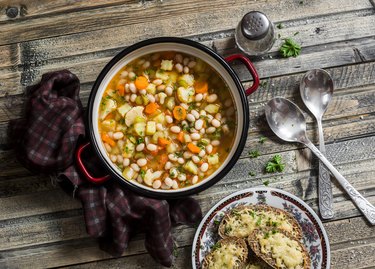
Beans are often grouped into the vegetable category, but they are not necessarily vegetables. Beans are in the legume family. This is a subgroup of the vegetable food group according to the USDA Dietary Guidelines, but consuming beans does not count toward your daily vegetable recommendations.
Per ChooseMyPlate.gov, adults should consume between 2 and 3 cups of vegetables per day. Any vegetable or vegetable juice counts toward this daily goal. Examples include 1 cup of dark, leafy greens, 1 cup of vegetable juice and 1 cup of mixed veggies.
Video of the Day
Video of the Day
Contrary to popular belief, beans count as a protein serving. You can substitute beans in place of poultry, beef, seafood, eggs or other protein sources. This is why many vegans, vegetarians and people who follow a plant-based diet often consume beans in their everyday diet.
Tip
Beans fall under the vegetable subgroup in the USDA Dietary Guidelines. However, beans are legumes and do not count as a vegetable serving. Rather, they count as a protein serving.
What Are Beans?
It can be difficult to know what food group beans belong to because the USDA and many other institutions refer to them as a subgroup of vegetables. However, beans belong in the legume family. According to Mayo Clinic, legumes are a class of vegetables. They can be eaten instead of meat, which is higher in fat and cholesterol.
There are many different types of beans. Some common bean types include this list of legumes:
- Black beans
- Pinto beans
- Kidney beans
- Cannellini beans
- Garbanzo beans
- Great northern beans
- Soybeans
- Mungbeans
- Adzuki beans
- Lima beans
The list of legumes also includes lentils and split peas, but most legumes that are highest in protein are beans.
If you follow a low-sodium or salt-free diet, such as the DASH diet, consider cooking your beans yourself. Many canned and frozen beans are high in sodium. Refried beans, chili beans and other pre-seasoned beans may also contain added ingredients, such as oil and lard, that can increase the calories, saturated fat and salt content of the beans.
Beans Are Protein Sources
ChooseMyPlate.gov includes beans as a source of protein that counts toward your daily servings of protein. Beans stack up alongside traditional sources of protein, which are mainly animal products such as eggs, poultry, game meat, deli meat and seafood.
According to the USDA, the top 10 beans in terms of protein include:
- Soybeans: 31.3 grams of protein per 1 cup
- Large white beans: 17.4 grams of protein per 1 cup
- Cranberry (roman) beans: 16.5 grams of protein per 1 cup
- Pinto beans: 15.4 grams of protein per 1 cup
- Kidney beans: 15.3 grams of protein per 1 cup
- Black beans: 15.2 grams of protein per 1 cup
- Navy beans: 15 grams of protein per cup
- Lima beans: 14.7 grams of protein per cup
If increasing your protein intake is your goal, consider substituting beans for animal protein. Beans are naturally cholesterol-free, making them a heart-healthy protein source for vegans, vegetarians and carnivores alike.
Consume More Beans
Add beans to your list of legumes to consume regularly. As you increase your consumption of beans for the many health benefits and nutrients, do not forget to eat your vegetables.
Beans are not substituted for vegetables because both of these foods are important in a well-rounded diet. However, beans can be substituted for animal-based protein sources.
You can add beans to soups, salads, stews, chilis and more. To consume beans and vegetables in one sitting, make a minestrone soup or vegetable chili. In doing so, you will have enjoyed both a vegetable serving and a protein serving.
- USDA Dietary Guidelines: “Appendix 3. USDA Food Patterns: Healthy U.S.-Style Eating Pattern”
- ChooseMyPlate: “All About the Vegetable Group”
- USDA Choose MyPlate: “Protein Foods Group Food Gallery”
- Mayo Clinic: “Beans and Other Legumes: Cooking Tips”
- MyFoodData: “Top 10 Beans and Legumes Highest in Protein”